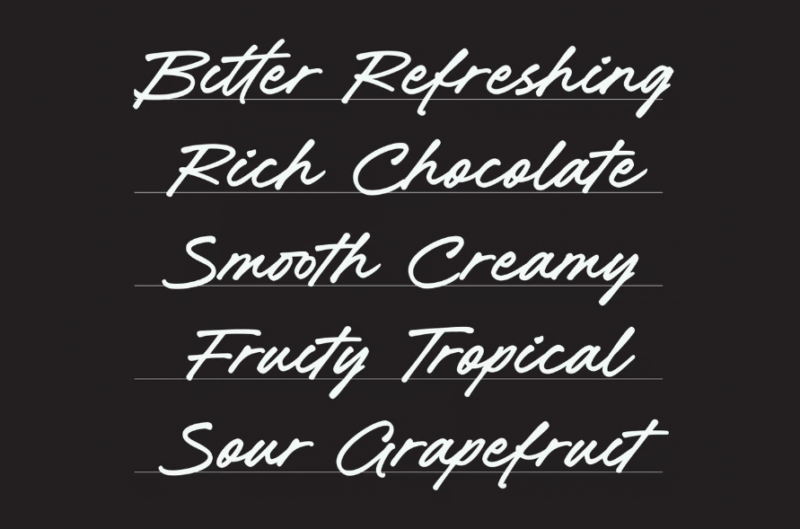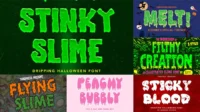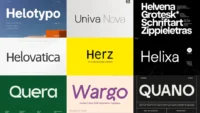In this article:
- Decoding the Cursive Code
- Taming the Cursive Beast: Rules of Engagement
- Cursive in the Wild: Modern-Day Applications
- Cursive Gems: A Curated Collection
- Wrapping Up
Cursive. The word might conjure up images of dusty calligraphy sets, your grandmother’s elegant handwriting, or maybe even a dreaded elementary school assignment. It’s a style often relegated to the realm of the “old-fashioned” – something better suited for wedding invitations and antique shop signage than cutting-edge design. But what if we told you that cursive fonts when used strategically, can bring a fresh, unexpected edge to modern projects?
This isn’t your typical design analysis; think of it as a deep dive into a world where classic elegance meets contemporary cool. We’ll journey from the historical roots of cursive – tracing its evolution from quill-and-ink to pixels and screens – and explore how this seemingly traditional style can be a powerful tool for innovative, eye-catching design.
Get ready to ditch the outdated perceptions and embrace the swoop. And if you’re looking for essay writing assistance that’s as stylish and effective as a well-chosen cursive font, feel free to check out our Essayservice review or two. And now, let’s dive in!
Decoding the Cursive Code
What makes a font truly “cursive”? It’s all about the connecting strokes. Unlike traditional print fonts, where each letter stands alone, cursive characters flow together, creating a sense of movement and rhythm. Ascenders (the upward strokes on letters like “h” and “l”) and descenders (the downward strokes on letters like “g” and “y”) intertwine, adding to the visual complexity and fluidity.
Flourishes, those extra loops and swirls, can amplify the elegance or add a touch of whimsy. Understanding these anatomical features is key to choosing the right cursive font for your project and ensuring it remains legible.
Beyond the technicalities, cursive fonts have a powerful psychological impact. They tap into our emotional responses, conjuring feelings of nostalgia, romance, and even luxury. A delicate, flowing script can evoke a sense of femininity and grace, while a bold, textured script might convey confidence and creativity.
Taming the Cursive Beast: Rules of Engagement
While cursive fonts offer immense creative potential, they require a deft hand to wield effectively. The first and most crucial rule? Legibility reigns supreme. A beautiful font is useless if no one can read it. Sans-serif or geometric fonts, with their clean lines and simple structures, provide the perfect counterpoint to the fluidity of cursive. A bold sans-serif headline paired with a delicate cursive subheading can create a striking contrast that draws the eye.

Get 300+ Fonts for FREE
Enter your email to download our 100% free "Font Lover's Bundle". For commercial & personal use. No royalties. No fees. No attribution. 100% free to use anywhere.
But remember, less is often more. Cursive fonts work best when used strategically as accents or highlights. Instead of setting entire paragraphs in cursive, consider using it for a single word, a key phrase, or a design element that needs to stand out. This “one-word wonder” technique can add a touch of elegance or personality without overwhelming the viewer.
Context is everything. Before you unleash a cursive font on your design, consider the overall aesthetic, the brand personality, and the target audience. A whimsical script might be perfect for a children’s book cover but completely out of place on a corporate website. Similarly, a formal script might feel too stuffy for a trendy fashion blog. By carefully aligning your font choice with the context of your project, you can ensure that your cursive selections enhance, rather than detract from, your message.
Cursive in the Wild: Modern-Day Applications
Move over wedding invitations (although we still love you!). Cursive fonts are making a serious comeback in the world of modern design, appearing in everything from logos and websites to product packaging and social media graphics. Brands are rediscovering the power of cursive to convey heritage, artistry, and a personal touch. Think of the elegant script logo of a luxury fashion house or the hand-drawn feel of a craft brewery’s branding.
- Websites are embracing cursive’s fluidity, using it to add a touch of sophistication to headers, navigation menus, and calls to action. Imagine a website for a high-end restaurant with a flowing script font welcoming visitors or an online boutique using cursive to highlight special offers.
But the digital realm offers even more opportunities for cursive to shine. Social media graphics, with their emphasis on visual appeal and personality, are a natural fit for cursive fonts. Think of inspirational quotes overlaid on beautiful imagery, Instagram stories with animated cursive text, or eye-catching Pinterest graphics that demand attention.
Even app designers are incorporating cursive into user interfaces, using it to create a more engaging and personalized experience. From subtle accents to bold statements, cursive fonts are proving their versatility in the ever-evolving landscape of digital design.
Cursive Gems: A Curated Collection
This isn’t your average font list. We’ve handpicked a selection of cursive fonts that go beyond the basics and embody the spirit of modern design.
- Playful & whimsical: Fonts like “Dancing Script” and “Pacifico” bring a lighthearted touch.
- Elegant & refined: “Great Vibes” and “Alex Brush” exude sophistication and grace.
- Bold & expressive: “Kaushan Script” and “Sacramento” make a statement with their strong personalities.
- Modern & minimalist: “Allura” and “Respective” offer a contemporary take on cursive with clean lines.
Wrapping Up
Ditch outdated perceptions and rediscover cursive’s elegance, personality, and expressive power in the modern age. Each font has its unique character, so experiment and find the perfect match for your project. The future is fluid, and cursive is leading the way.





